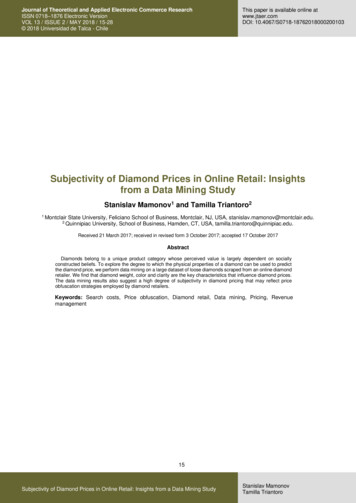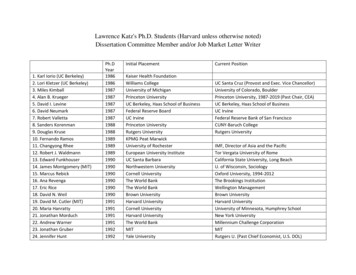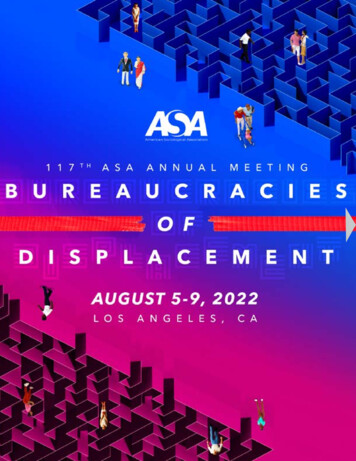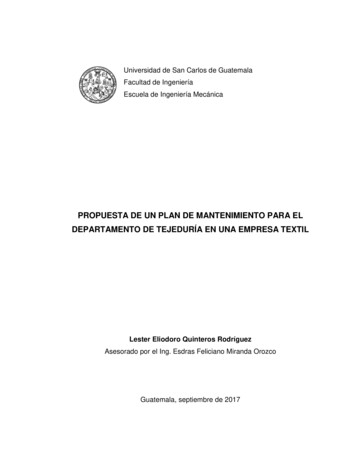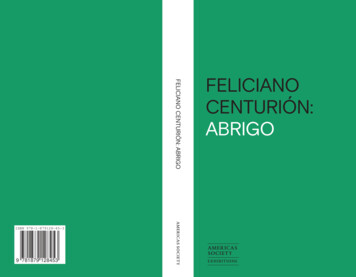
Transcription
FELICIANO CENTURIÓN: ABRIGO9 781879 128453AMER ICAS SOCIET YISBN 978-1-879128-45-3FELICIANOCENTURIÓN:ABRIGOAMER ICASSOCIET YE XH I BI T IONS
FELICIANOCENTURIÓN:ABRIGOAMER ICASSOCIET YE XH I BI T IONS
Alejandro Leroux, Feliciano Centurión, c. 1989–92
abrigo, m. 1. overcoat; wrap. 2. shelter, sheltered place.3. (mil.) shelter; cover. 4. (fig.) help, protection. 5. (mar.)harbor, inlet, cove. 6. (archeol.) small, shallow cave. 7. (Arg.)blanket; quilt.— al a. de, sheltered by, protected by, undercover of; estar al a. de, to be protected by; a. antiaéreo,bomb shelter.“abrigo,” Tana de Ganiez. Simon & Schuster’s International DictionaryEnglish/Spanish – Spanish/English, New York: Simon & Schuster, 1973
CONTENTS9ForewordSusan Segal15AbrigoGabriel Pérez-Barreiro29South American Jungle TalesAimé Iglesias Lukin41Exhibition Checklist108Exhibition History114Bibliography119Acknowledgments
FOREWORDAmericas Society is pleased to present FelicianoCenturión: Abrigo, the first institutional exhibition of the Paraguayan artist’s work outsideLatin America. Centurión was a key figure inearly 1990s cultural circles in Buenos Aires,Argentina, and was known for his engagementwith folk art and queer aesthetics.Now, some twenty years after his death,Feliciano Centurión’s work is starting to attractthe attention it deserves. As with many artists from Latin America, his work was notwidely exhibited or collected in his lifetime.This exhibition, then, provides a much-neededopportunity to trace the short but vibrantcareer of a remarkable artist.9
I am grateful to this exhibition’s guestcurator, Gabriel Pérez-Barreiro, for hiswork in bringing Centurión to a New Yorkaudience. It is a pleasure to have him backat Americas Society, after his directorshiphere in 2000–2002. I welcome and congratulate Aimé Iglesias Lukin, Director and ChiefCurator of Visual Arts at Americas Society.This exhibition is representative of the pioneering programming we expect from hertenure here.I am thankful to Karen Marta and her colleague Todd Bradway for their editorial supportand to Garrick Gott for designing this publication series. Diana Flatto, Assistant Curator, andCarolina Scarborough, Assistant Curator ofPublic Programs, deserve special recognitionfor their work to deliver high-caliber exhibitions and related events.The presentation of Feliciano Centurión:Abrigo is made possible by the generous support of waldengallery, Galeria Millan, andCecilia Brunson Projects. This exhibitionis supported, in part, by public funds fromthe New York City Department of CulturalAffairs in partnership with the City Council.Additional support is provided by SharonSchultz.This exhibition presents works kindly lentby the artist’s estate, represented by CeciliaBrunson Projects, and also by waldengallery, and institutions including the BlantonMuseum of Art, University of Texas at Austin;the Solomon R. Guggenheim Museum, NewYork; and the Fundación Museo Reina Sofía,Madrid. We are also grateful to private lenders Amalia Amoedo, Estrellita B. Brodsky,Colección Brun Cattaneo, Adriana Cisnerosde Griffin, Eduardo F. Constanini, HochschildCorrea Collection, Donald R. Mullins Jr., RaúlNaón, and other collectors who haven chosen to remain anonymous, and we extend ourthanks to Mon Ross for allowing her documentary on Centurión’s life and work, AbrazoÍntimo al Natural, to be shown as part of theexhibition.On the occasion of Feliciano Centurión:Abrigo, Americas Society is publishing the1011
first comprehensive monograph on the artist’swork, with the support of the Institute forStudies on Latin American Art (ISLAA).Americas Society acknowledges the generous support from the Arts of the AmericasCircle members: Estrellita B. Brodsky; KaeliDeane; Diana Fane; Galeria Almeida e Dale;Isabella Hutchinson; Carolina Jannicelli; DianaLópez and Herman Sifontes; Luis Oganes;Gabriela Pérez Rocchietti; Vivian Pfeifferand Jeanette van Campenhout, Phillips;Erica Roberts; Sharon Schultz; and Edward J.Sullivan.SUSAN SEGALPRESIDENT AND CEO, AS/COA12
ABRIGOGabriel Pérez-Barreiro
Feliciano sits at a table in one of Buenos Aires’sglamorous old-world cafés or hotels. He looksdirectly at the camera with an expression that isboth dramatic and seductive; his ringed fingersclutch his torso in an operatic contrapposto thatcould be entirely serious, or not. The iconicphotograph by Alberto Goldenstein shows usthe artist at the prime of a tragically short life:confident, handsome, realized. Within threeyears Feliciano Centurión would be dead, oneof the countless victims of the HIV/AIDS epidemic that decimated an entire generation.Alberto Goldenstein, Feliciano Centurión (from the seriesMundo del arte [Art world]), 1993/2018PARAGUAY: THE SUBTROPICAL JUNGLEFeliciano Centurión was born in San Ignacio,in the southern region of Paraguay, close tothe Argentine border. San Ignacio was one ofthe settlements created by the Jesuits in theseventeenth and eighteenth centuries. TheJesuit missions have often been characterizedor romanticized as the softer face of colonization, with the Guarani and Catholic traditionsliving in relative harmony. Regardless of17
the degree of truth that supports this perhaps idealistic vision, the Jesuits did indeedbring the European Baroque to this region,and built many ornate churches that weredecorated with hybrid indigenous/Catholicelements. This coexistence of Guarani andCatholic cultures forged a unique culture inParaguay, a country that was emerging asa regional superpower until the War of theTriple Alliance (1864–70), in which neighboringBrazil, Argentina, and Uruguay, supportedby European powers, devastated the country, killing 90 percent of the male population.After this war, Paraguay never recovered, andbecame something of a regional backwater, alandlocked republic that, in the popular imagination, was plagued by drug traffickers, Naziwar criminals, Islamic terrorists, and the longshadow of the thirty-five-year dictatorshipof Alfredo Stroessner. On the other side ofthis coin, however, is a country with the mostethnically mixed population in the Americas,one of the few countries where an indigenouslanguage, Guarani, is the official language spoken by 90 percent of the population, and witha distinct cultural heritage that is markedlydifferent from the better-known civilizationsof the Andes or Mesoamerica.Centurión grew up in this context, in ahousehold dominated by women, in which helearned to sew and crochet. As part of its complex cultural makeup, Paraguay is justly famousfor its crafts, especially ñandutí, an elaboratehandmade lace inspired by models importedfrom the Canary Islands during colonizationand baptized with the Guarani word for “spider’s web.” As a young boy, Centurión was bothattracted to the crafts traditionally associatedwith women, and also made to feel uncomfortable for not following more conventionallymasculine interests. When the family movedto the border town of Alberdi, he attended theart school in Formosa, just across the ParaguayRiver in Argentina. As a student he made fairlyconventional still lifes and landscapes, albeitwith a certain moody intensity. His teacher1819
encouraged him to follow his dreams and continue his artistic career in a bigger city.BUENOS AIRES: THE URBAN JUNGLEIn 1980 Centurión moved to Buenos Aires tostudy at the national art schools. More important than the training, which was somewhattraditional, was the vibrant cultural milieuin which he now found himself. By the mid1980s, Argentina was emerging from a brutaldictatorship, and artists and intellectuals wereenjoying new freedoms and expressive possibilities. The previous generation was largelydefined by its opposition to the military regime,and this broadly societal concern shaped theart scene, from expressive tortured figurationto intellectually encoded conceptualism. In anewly democratic society, the political focusshifted from the general to the specific, from thesociological to the intimate. The artist MarceloPombo, a friend of Centurión’s, famouslydefined politics at the time as the square meterimmediately surrounding the artists: friends,20family, neighbors. This was where politics wasmanifested and where it could be effective.Centurión felt liberated not only by thisnew artistic spirit, but also by the ability to beopen in his sexuality. These issues were closelyrelated: as the expression of individual subjectivity, sexuality itself became a contestedsite, as evidenced by the phrase, The personalis the political. What, after all, was the point ofpolitical freedom if it couldn’t be expressed atthe most personal and everyday level?In the late 1980s a small and unassuminguniversity cultural center, the Centro CulturalRicardo Rojas (El Rojas), became the epicenter of an unexpected revolution in the visualarts. Under the directorship of the artistJorge Gumier Maier, El Rojas championed anew generation of artists whose shared concerns included the everyday, self-expression,an interest in kitsch aesthetics, and an exuberant, almost Baroque, aesthetic. Centuriónbecame a core member of this group of artists,showing several times at El Rojas, and in many21
ways exemplifying the aesthetic choices of thatgeneration. Around this time, he stopped producing expressive figurative paintings (manywith homoerotic overtones) and started toengage with fabric, crochet, and embroidery.He would often go hunting for kitsch domesticdoilies and tablecloths in Once, the popularfabric district of Buenos Aires, reveling in theirbright colors and ornate sentimentalism.In the early 1990s Centurión started painting exotic animals on the large, cheap syntheticblankets used for household packing and forshelter by the homeless. The contrast betweenthe poverty of the material and the exuberance of the bold and expressive animals shows aremarkable confidence and originality for sucha young artist. Some of the animals depictedrelate directly to Centurión’s subtropical origins: yacares (small crocodiles), lizards, andsurubí (large river fish native to the region).Others are more clearly fantastical, such as aseries of octopuses, jellyfish, and anemones. Fora related series, Centurión purchased blanketswhose designs featured exotic scenes of tigers,deer, and other animals, and painted over thepreexisting patterns to further exaggerate theexcessive cuteness of their mass-market appeal.In both series, Centurión brought together twoapparently opposed universes: the natural andthe urban, the organic and the synthetic.2223THE POETICS OF AFFECTAs Centurión continued his exploration of popular and folk fabrics and traditions, he beganto engage more with embroidery and crochet.In many works he would take a preexistingpillowcase, coaster, apron, or tablecloth, andadd a poignant hand-stitched phrase. Thesephrases or aphorisms tend to concern love,with such declarations as Te quiero (I love you)and Descansa tu cabeza en mis brazos (Rest yourhead in my arms). Others evoke more abstractstates such as Añoranza (Longing) and Ensueño(Dream), and another subset uses religious references such as El cielo es mi protección (Heavenis my protection) and Tu presencia se confirma en
nosotros (Your presence is confirmed within us).In all of these works there is a tender wish toexpose intimate emotions in a direct way, usingthe traditionally feminine medium of embroidery. Centurión’s engagement with popularaesthetics also disarms the viewer, as many ofus have memories of precisely this kind of crocheting or embroidery in our grandparents’ orfamily homes, but we don’t expect to encounterit in contemporary art.In bringing affection and love to the center of his practice, Centurión was making astrong political statement, but one groundedin the politics of affection, relationships, andintimacy. Discarded or forgotten objects wererecovered and given new meaning by carryingheartfelt messages, in a series of small acts withpotentially large consequences.AIDS AND THE POETICS OF DEPARTUREAfter Centurión was diagnosed with HIV, at atime when there was no accessible treatment,he began to incorporate references to his illnessin his work. In common with Félix GonzálezTorres, ACT UP, José Leonilson, and GeneralIdea, Centurión used his art to register the tollof illness on his body, and also provide a counternarrative to the “gay plague” hysteria in themass media.Death and religion started to appear regularly in the phrases Centurión applied tohis works. His Christian faith seems to havebecome more pronounced or at least more visible through the frequent use of the cross oreven, in one work, a sacrificed lamb (a commonmetaphor in the Catholic tradition). In the finalseries of pillows he made while hospitalized, headded the phrase “Luz divina del alma” (Divinelight of the soul), as though recovering thebeauty of the human soul as his physical bodywas decaying out of existence.After his arrival in Buenos Aires, south ofhis native Paraguay, Centurión suffered fromthe cold winters of the Río de la Plata region. Hissearch for warmth—physical and emotional—characterized his short but brilliant career. In a2425
particularly humorous series, he dressed dolls anddinosaurs in hand-crocheted garments, therebyneutralizing their fierce postures and expressions,and feminizing and domesticating them. In a careerdefined by various forms of marginalization, fromhis Paraguayan origins to his sexuality to his interest in popular and folk traditions, Centurión’s formof activism and resistance was intimate and affective, focusing on love, spirituality, and humor—theshelter, or abrigo, that art can provide in a hostileworld.26
SOUTH AMERICANJUNGLE TALESAimé Iglesias Lukin
Feliciano Centurión, “Petit diccionario guaraní” (LittleGuarani dictionary),” n.d. Archive Elizabete Costa“Rojhaijú: te quiero [I love you]” reads the firstentry of the “Little Guarani Dictionary” handwritten by Feliciano Centurión on a small pieceof paper given to his friend Bete Costa.i Affectand Paraguay are the two key aspects throughwhich to read the art of Centurión, a small butpowerful body of work in which love, friendship, and community are central themes, mademanifest using textile techniques of popularorigin that depict the flora and fauna of theregion’s subtropical jungle.Born and raised in the rural towns and smallcities of the Paranaense Forest, which coversParaguay, Argentina, and Brazil, Centuriónmoved after high school to Buenos Aires in themid-1980s. Quickly inserting himself in localart circles, he played an important role in theactivities of the Centro Cultural Ricardo Rojasfrom 1989 onward, while maintaining an activerelationship with Paraguay, where he exhibited and traveled often. The urban jungle ofpost-dictatorship Buenos Aires offered him theopenness and inclusiveness in which to develop31
his work and to live as a queer man, while hisiconographic imaginary, inspired by the naturaljungle of his native Paraguay, brought attentionto his work in the city and beyond. This uniquecombination of the rural and the metropolitan,the traditional and the popular, of sentimentand witticism, make his work both a productof its time and a unique reinterpretation ofParaguayan traditions.iiThe late 1980s and early 1990s constitutea pivotal moment in South American culture.In a world already shaken by the fall of theBerlin wall and the end of the Soviet Union,many countries in the region saw the returnof democracy and the beginning of neoliberalpolitics. In a metropolis like Buenos Aires, theopenness after years of censorship and repression translated into a bursting cultural scenein which underground circles rapidly grew,even coming to the attention of the mainstreammedia. Pop, kitsch, and queer aesthetics playedkey roles in the literature, theater, cinema, andarts of the period, which, in many cases, tookmultidisciplinary form. Leaving a profoundmark on regional culture as well, this periodis key to understanding much contemporaryartwork, and is only recently coming withinthe purview of academia and art institutions.In the United States, key precedents of suchstudies in the visual arts can be found in therecent exhibitions Recovering Beauty: The 1990sin Buenos Aires, held at the Blanton Museum ofArt of the University of Texas at Austin, in 2011,and José Leonilson: Empty Man, held at AmericasSociety in 2017–18.Representing his north–south biographicalitinerary, Feliciano Centurión offers us a bodyof work that is unique in 1990s South Americanart, in which kitsch aesthetics and queer affectare conducted through the appropriation of traditionally feminine textile techniques such asembroidery and ñandutí lace. His iconographyis equally distinctive: flowers and animals fromhis native Paraguay are combined with tigers,deer, octopuses, and dinosaurs from the cheapblankets and plastic toys he used in his work.3233
Centurión’s path was preceded—in theinverse direction and eighty years before—bythe Uruguayan writer Horacio Quiroga, whomoved from Buenos Aires to the rainforest inMisiones province and published, in 1918, thefamous book Cuentos de la selva (Jungle Tales), acollection of short horror stories in which animals talk and nature is presented as dangerousand almighty in the face of the human desirefor domination.iii In the case of Centurión, theeffect is the opposite: the natural world he grewup in is presented as playful, naive, and kitsch.Nature is not threatening but still powerful andmagical, and, in fact, it is precisely throughthe ancient cultural connection to nature—themagical ritual—that the work of Centurióncan be better understood, not only as beautifulbut also as powerfully political. The art criticClaudio Iglesias writes:in which the problems of globalization couldfind a peculiar response, in terms differentboth from the stock phrases of global neoconceptualism and from any attempt of culturalreaction in terms of local conditioning. Tospeak of magic and ritual, in this sense, is tospeak of cultural agency in a wider sense.ivartisan[al] techniques thus form a constellationWhat led Centurión to combine the real faunaand flora of his homeland with an expandedbestiary from other climates? Part of theanswer is practical, as, in some of his works,he painted over the animals that decorate thecheap blankets sold in the discount stores ofBuenos Aires. But a more insightful answerwould reveal Centurión’s understanding ofthe fact that both fiction and the mythical arenecessary parts of his message about nature.His depictions of plants and animals constitute agarden of delights in which memory and imagination work equally to uphold his Paraguayanidentity and assert his rightful place, not onlyin the Buenos Aires art scene but also in Brazil3435The flora and fauna of Paraguay, the differentforms of the esoteric, and the reclaiming of
and Cuba, and internationally. His position inBuenos Aires was, after all, that of a migrant,and he wore his Paraguayan origins politically,using his identity to break down barriers andinitiate dialogues with those who encounteredhis work.His work narrates stories of the self—his love life, his diseasev—but also stories ofa cultural body searching for a new politicalexpression in a changing world. If this expression could not, in the 1990s, take its placeamong the great discourses that had shapedpostwar artistic ideologies, Centurión and hisgeneration found a path through the personal,the local, the folkloric and the popular, a paththat gave voice to queer identities in every senseof the term.In a 1994 letter to Bete Costa, Centurióncelebrates the attention his work is receivingand imagines “a newspaper article that wouldtell ‘of how a Paraguayan born in San Ignacio delas Misiones in 1962 becomes an artist in 1990sBuenos Aires’ or, like the advertisement forVirginia Slim cigarettes, ‘You’ve come a longway, baby.’”vi And yes, while he never lost sightof his roots, Centurión certainly did come avery long way.3637
ENDNOTESiiiiiiivvviFeliciano Centurión, “Petit diccionario guaraní,” n.d. Archive ElizabeteCosta.See, in this regard, Ticio Escobar, “Extreme Ornamentation,” in GabrielPérez-Barreiro and Fabiana Werneck, eds., 33rd Bienal de São Paulo: AffectiveAffinities (São Paulo: Fundaçao Bienal de São Paulo, 2018), 1–8.See Horacio Quiroga, South American Jungle Tales, trans. Arthur Livingston(New York: Duffield, 1922), and Noé Jitrik, Horacio Quiroga: una obra deexperiencia y riesgo (Sáenz Peña: Editorial de la Universidad Nacional deTres de Febrero, 2018).Claudio Iglesias, “Autobiografía, hiperestesia y ritualidad: FelicianoCenturión y algunos posicionamientos subyacentes a la objetualidad delos noventa en Argentina,” in Vínculos rituales y retazos de magia. Una antologíade Feliciano Centurión en diálogo con Liliana Maresca, Omar Schiliro y FernandaLaguna (Buenos Aires: Galería Alberto Sendrós/arteBA, 2010).Centurión was diagnosed with HIV/AIDS in 1996; he died on November7 of that year.Feliciano Centurión, letter to Bete Costa, March 24, 1994. Archive ElizabeteCosta.
EXHIBITION CHECKLIST
Cangrejos (Crabs), 1990–93. Acrylic on blanket, 88 ¼ 76 ¾ inches(224.2 194.9 cm). waldengallery, Buenos Aires42De la serie Mantas (Langostinos) (From the bedspread series[shrimps]), n.d. Acrylic on blanket, 83 ¾ 74 inches(213 188 cm). Private collection, Miami43
Pulpo violeta (Purple octopus), 1993. Acrylic on blanket, 78 ¾ 74 inches(200 190 cm). Collection of Adriana Cisneros de Griffin44Medusas (Jellyfish), 1994. Acrylic and crochet on blanket,78 ¾ 74 ¾ inches (200 190 cm). Fundación Museo ReinaSofía, Madrid45
Surubí, 1992. Acrylic and enamel on blanket, 78 ¾ 74 ¾ inches(200 190 cm). waldengallery, Buenos Aires47
Familia de dinosaurios (Family of dinosaurs), c. 1990. Plastic toyswith crochet, variable dimensions. Private collection, New York49
Estrella del mar (Sea star), c. 1990. Embroidery on blanket andacrylic paint, 19 ¼ 15 inches (49 38 cm). Estate of the artist;familia Feliciano Centurión51
De la serie Mantas (From the bedspread series), 1994. Acrylic onblanket, 24 /7 8 22 ¼ inches (63.2 56.5 cm). Private collection,New York52De la serie Frazadas (From the blanket series), 1994. Acrylic onblanket, 92 78 inches (233.7 198.1 cm). Private collection, NewYork53
Untitled, 1994. Acrylic on blanket, 19 ¾ 20 /7 8 inches (50.2 53 cm).Private collection, New York54Untitled (Deer), 1994. Acrylic on blanket, 23 /7 8 19 ¾ inches(60.6 50.2 cm). Private collection, New York55
Lagartijas (Lizards), 1990–93. Acrylic on blanket, 77 1 8 57 1 8 inches(196 145 cm). waldengallery, Buenos Aires57
Tigres (Tigers), 1993. Acrylic on blanket. 70 7 8 72 ¾ inches(180 185 cm). Private collection, Buenos Aires59
Ave del paraiso florecido (Bird of flowering paradise), c. 1995.Embroidery on fabric, 16 ½ 22 ½ inches (42 57 cm). Privatecollection, London61
Dichoso sera el pajarito . . . (Blessed will be the little bird . . .), c.1995. Embroidery on pillow case, 17 26 inches (43.2 66 cm).waldengallery, Buenos Aires62Ensima de esta flor (On top of this flower), c. 1995. Embroidery onfabric, each 17 26 inches (43.2 66 cm). Collection of Raúl Naón,Buenos Aires63
Flores del mal de amor (Flowers of lovesickness), 1996. Sixembroideries on fabric, each 12 ½ 26 inches (32 66 cm). EduardoF. Costantini Collection, Buenos Aires65
Estoy vivo (I am alive), 1994. Embroidery on fabric, 18 20 inches(46 51 cm). Collection of Estrellita B. Brodsky67
El cielo es mi protección (Heaven is my protection), 1995. Embroideryon fabric, 17 ¾ 18 ¼ inches (45 46 cm). Estate of the artist; familiaFeliciano Centurión68Descansa tu cabeza en mis brazos (Rest your head in my arms), 1995.Embroidery on fabric, 21 ¼ 18 ½ inches (54 47 cm). Estate of theartist; familia Feliciano Centurión69
Que en nuestras almas no entre el terror (May fear not enter our souls),1992. Embroidery on fabric, 14 ½ 16 ½ inches (37 42.5 cm).waldengallery, Buenos Aires71
Estoy despierto (I am awake), 1990–93. Acrylic paint and thread onnatural and synthetic fibers, 13 ¼ 10 ¼ inch (33.3 25.4 0.6 cm).Solomon R. Guggenheim Museum, New York72Germinar (Germinate), c. 1990. Embroidery on fabric, 10 ¾ 12 ½inches (27 32 cm). Private collection, New York73
Flor (Flower), c. 1990. Ñandutí on blanket, 11 ¾ 13 ¾ inches(30 35 cm). Private collection, New York74Florece (Flourishes), 1990–93. Embroidery and thread on naturaland synthetic fibers, 19 ¼ 21 ½ ½ inch (8.9 54.6 1 cm).Solomon R. Guggenheim Museum, New York75
Busco refugio (I seek shelter), 1990–93. Embroidered fabric on blanket,20 ½ 20 ½ inches (52 52 cm). waldengallery, Buenos Aires76Paraíso florecido (Flowering paradise), c. 1995. Embroidery onblanket, 15 ¾ 15 ¾ inches (40 40 cm). Estate of the artist;familia Feliciano Centurión77
Ensueño (Dream), 1995. Embroidery on fabric, 19 ¾ 19 ¾ inches(50 50 cm). Hochschild Correa Collection79
Tu presencia se confirma en nosotros (Your presence is confirmedin us), n.d. Ñandutí on blanket, 20 ¾ 21 ¼ inches (53 54 cm).Collection of Amalia Amoedo, Buenos Aires80Florece mi corazón (My heart flowers), 1992. Embroidery on fabric,22 ½ 20 ¾ inches (57 53 cm). waldengallery, Buenos Aires81
Eres una flor única (You are a unique flower), 1994. Embroidery onfabric, 81 ½ 59 inches (207 150 cm). Hochschild Correa Collection83
Gallinas (Chickens), c. 1990. Embroidered woven coasters onblanket, 22 3 8 17 3 8 inches (57 44 cm). Estate of the artist;familia Feliciano Centurión85
Añoranza (Longing), n.d. Embroidery on fabric, 19 ¼ 16 ½ inches(49 42 cm). Estate of the artist; familia Feliciano Centurión87
Mi casa es mi templo (My house is my temple), 1996. Embroideryon fabric, 13 26 inches (33 66 cm). Estate of the artist; familiaFeliciano Centurión88Vivir es todo sacrificio (Living is all sacrifice), 1996. Embroidery onfabric, 21 ½ 17 inches (55 43 cm). Estate of the artist; familiaFeliciano Centurión89
Corazón marchito (Withered heart), c. 1994. Embroidery on blanketwith crochet, 35 34 inches (89 86.5 cm). Estate of the artist; familiaFeliciano Centurión90Florece (Flourishes), 1995. Embroidery with inclusion on blanket,24 3 8 21 ¼ inches (62 54 cm). Estate of the artist; familiaFeliciano Centurión91
Las flores llenan de perfume (The flowers fill with perfume), c. 1995.Embroidered cloth patch with intervention on blanket, 23 ¼ 20 ½inches (59 52 cm). Estate of the artist; familia Feliciano Centurión92Escucha el latido de tu corazón (Listen to the beat of your heart),c. 1995. Embroidery on blanket, 11 7 8 11 7 8 inches (30 30 cm).Estate of the artist; familia Feliciano Centurión93
Cordero sacrificado (Sacrified lamb), 1996. Acrylic on polyesterblanket, 93 51 ½ inches (236.2 130.8 cm). Blanton Museum ofArt, The University of Texas at Austin95
La muerte es parte intermitente de mis dias (Death is an intermittent part ofmy days), 1990. Embroidery on fabric, 19 ½ 27 ½ inches (50 70 cm).Collection of Donald R. Mullins Jr.96Renazco a cada instante (I am reborn at every moment), 1995.Embroidery on fabric, 13 ¾ 20 ½ inches (35 52 cm). Estate ofthe artist; familia Feliciano Centurión97
En el silencio del descanso . . . (In the silence of my rest . . .), c. 1996.Embroidery on fabric, 18 21 inches (43 74 cm). Collection ofRaúl Naón, Buenos Aires98Mis globulos rojos aumentan (My red blood cell count increases),c. 1996. Embroidery on fabric, 16 ½ 27 ½ inches (42 70 cm).Colección Brun Cattaneo, Buenos Aires99
Soy alma en pena (I am a soul in pain), 1995. Embroidery on fabric,23 16 ½ inches (59 42 cm). Estate of the artist; familia FelicianoCenturión101
Reposa (Rest), c. 1996. Hand-embroidered pillow, 8 ¾ 15 inches(22 38 cm). Blanton Museum of Art, The University of Texasat Austin102Luz divina del alma (Divine light of the soul), c. 1996. Handembroidered pillow, 8 ¾ 15 3 inches (22.2 38 7.3 cm).Blanton Museum of Art, The University of Texas at Austin103
Soledad (Solitude), c. 1996. Hand-embroidered pillow, 10 ¼ 16inches (26 43 cm). Blanton Museum of Art, The University ofTexas at Austin104Sueña (Dream), c. 1996. Hand-embroidered pillow, 8 ¾ 12 ¼inches (22 31 cm). Blanton Museum of Art, The University ofTexas at Austin105
Mon Ross, Abrazo íntimo al natural (Intimate embrace naturally),2016. Film107
EXHIBITION HISTORYSolo Exhibitions2019 Feliciano Centurión: I am Awake, Cecilia BrunsonProjects, London, United Kingdom2018 Solo artist presentation, 33rd Bienal de São Paulo:Affective Affinities, São Paulo. Brazil2016 National University of Ireland, Maynooth, Ireland2013 Feliciano Centurión: Las intensidades de la belleza,Centro Cultural de España “Juan Salazar,”Asunción, Paraguay2012 Bocetos y dibujos. Papeles previos by Feliciano Centurión,Alberto Sendrós Gallery, Buenos Aires, Argentina2004 Feliciano Centurión, Galería Alberto Sendrós, BuenosAires, Argentina1999 Feliciano Centurión – Últimas obras, Centro Culturalde España Juan Salazar, Asunción, Paraguay1997 Galería Ruta Correa, Freiburg, Germany1996 Retrospectiva, Centro de Artes Visuales Isla de Francia,Asunción, ParaguaySalón Hugo del Carril – Premio Fundación Banco de laCiudad de Buenos Aires, Museo de Arte Moderno,Buenos Aires, Argentina1994 Estrellar, Centro Cultural Ricardo Rojas, Universidadde Buenos Aires, ArgentinaArte, sociedad y reflexión: Quinta Bienal de La Habanamayo 1994, Havana, CubaFeliciano Centurión, Centro Cultural Ricardo Rojas,Universidad de Buenos Aires, Argentina108199319921991199019871985Frío / Caliente, Centro Cultural Borges, Buenos Aires,ArgentinaFeliciano Centurión, La Galería, Manzana de la Riveray Centro Cultural de la Ciudad, Asunción,ParaguayPinturas: Feliciano Centurión, Centro Cultural
americas society americas society exhibitions feliciano centuriÓn: abrigo feliciano centuriÓn: abrigo 9 781879 128453 isbn 978-1-879128-45-3 ams_exhib_centurion_cover_r6_g.indd 1 1/24/20 10:40 am
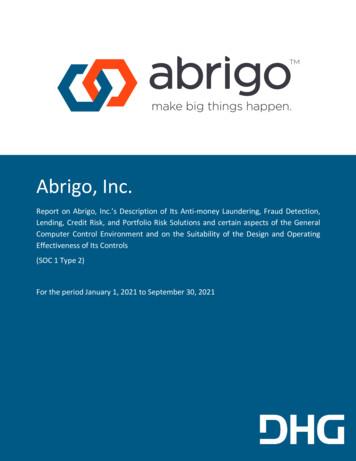
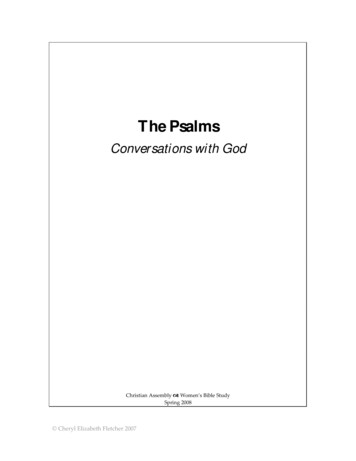
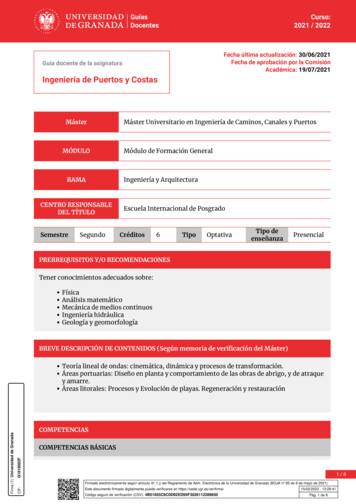
![WELCOME [ losmedanos.edu]](/img/30/graduationprogram22v3mech.jpg)
